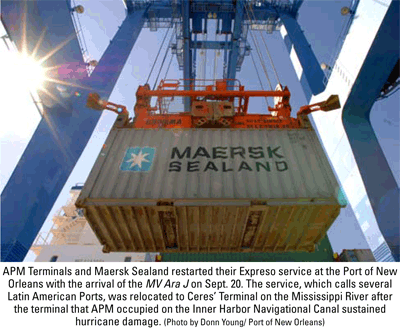A long-term shipping partner of the Port of New Orleans returned one of its two former weekly services to the Crescent City on Sept. 20, a move that will spur continued growth in container business.
Port President and CEO Gary LaGrange made the announcement during his annual State of the Port Address to the World Trade Club of New Orleans at the Plimsoll Club atop the World Trade Center.
 The MV Ara J called on the Port this morning, marking the return of APM Terminals and Maersk Sealand's weekly Expreso Service to Central and South America. The vessel called on Ceres Gulf's terminal at the Napoleon Avenue Container Terminal.
The MV Ara J called on the Port this morning, marking the return of APM Terminals and Maersk Sealand's weekly Expreso Service to Central and South America. The vessel called on Ceres Gulf's terminal at the Napoleon Avenue Container Terminal.
'The ports that Maersk serves with its Expreso Service are crucial, especially with the advent of the Central American Free Trade Agreement,' LaGrange said. 'We want to continue to grow that business in New Orleans and work with our friends and business partners in Latin America. This is vital to restoring our container business in the Port of New Orleans.'
During the first six months of 2006, containerized cargo was down 33%, primarily due to the absence of Maersk Sealand, whose facility at the France Road Container Terminal sustained severe flood and wind damage. That terminal constituted one-third of the port's container terminals. LaGrange thanked Rob Baigrie, Maersk's port director for the company's operations in Houston and New Orleans.

'We are elated to have one of two services back,' LaGrange said. 'It might be a long shot, but we will do everything in our power to have the second service return, as well.'
Baigrie commented, 'Maersk is very pleased to return to New Orleans with the Expreso Service. We are continually looking to create global opportunities for our customers. We look forward to being able to bring business to the Port of New Orleans as this area rebuilds.'
Four ships are employed in Maersk's service. Prior to Hurricane Katrina, the full service generated about 30,000 containers per year, or 600 containers per week. The cargo is primarily coffee and apparel. The ships call on the ports in Cartagena, Colombia; Manzanillo, Panama; Puerto Limon, Costa Rica; Puerto Cortez, Honduras; Santo Tomas, Guatemala; Progreso, Mexico; New Orleans, and Houston.
Latin American trade can prove to be a boon for the Port of New Orleans. A study conducted by LSU economist Jim Richardson found Latin American trade in Louisiana could generate new business sales of $169 million to $339 million and create up to 2,769 new jobs due to the adoption of the Central American Free Trade Agreement in 2005. The returning service compliments the Port's existing regular services to Latin America provided by Mediterranean Shipping Company, Hapag-Lloyd and SeaBoard Marine.
In conjunction with the announcement, LaGrange offered an overview of the current status and future of the Port, first thanking the entire Port community for their work in restoring tonnage and ship-call levels to pre-Katrina levels as of May 2006.
'Clearly, this industry can rightfully boast that it was the first industry back up and running after Hurricane Katrina,' LaGrange said. 'Phenomenal is the only way to describe it, especially considering that this Port sustained $164,236,000 in damages to its facilities and lost critical deep-draft access to about 25% of its terminal operations.'
Downward figures in container cargo were offset by a more than 28% rise in breakbulk cargo. Imported steel, for instance, was up more than 19% in the first six months of 2006, compared to same period one year ago.
'These figures helped temporarily to make the difference,' LaGrange said. 'However, the Port's problems won't be fully solved until we have replaced the capacity we lost at the France Road terminals








